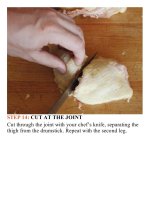The food lab better home cooking through science ( PDFDrive ) 62
Bạn đang xem bản rút gọn của tài liệu. Xem và tải ngay bản đầy đủ của tài liệu tại đây (65.43 KB, 2 trang )
ever slicing your onions thin enough for that soup).
And,again,remembertohoneyourknifeonasteel
every time you use it. While this process won’t
actuallytakeanymaterialofftheblade(seehere),it
will help keep the blade aligned, making slicing and
dicingmucheasier.
Step-by-Step:HowtoSharpenaKnife
Step 1: Work in Batches. Although it’s worth the
effort, knife sharpening can take a bit of effort and
time. If you’re going to be setting up a station to
sharpenaknife,thinkaheadandsharpeneveryknife
that may need sharpening to get the whole process
doneinonesessioninsteadofseveral.
Step 2: Soak Your Stone(s). When working with
water stones, it’s essential to submerge them in
water for at least 45 minutes before using. If the
porous stone is not fully saturated, it will dry out
during sharpening, causing the knife blade to catch
and giving your edge nicks and dings. If you have
two, soak both your stones, as well as your stone
fixer.
Step 3: Set UpYour Station. Place your stone on a
towel laid on a cutting board. Keep a container of
water nearby to keep your stone moistened during
thesharpeningprocess.Thestoneshouldbeoriented
withashortendparalleltotheedgeofthecounter.
Step4a:BegintheFirstStroke.Holdyourknifewith
the blade edge pointing away from you. Place the
heel of your knife on the far edge of the stone and,
holding the blade gently but firmly with both hands
ata15-to20-degreeangleandusingevenpressure,
slowly drag the knife over the stone toward you
down its length while simultaneously moving the
knifesothatthecontactpointmovestowardthetip
oftheblade.
Step 4b: Maintain theAngle. Be careful to maintain
the 15- to 20-degree angle as you pull the knife
acrossthestone.Pressureshouldbefirmbutgentle,
andthebladeshouldglidesmoothlyacrossthestone.
Step5:Repeat.Eachstrokeshouldfinishwiththetip
of the knife touching the bottom edge of the stone.
Lift the knife, reset the heel at the top edge of the
stone,andrepeat.
Step 6: Look for Silty Water. As you repeat the
process, a thin film of silty-looking water should
collect on top of the stone and on the blade. This
abrasive liquid will gradually take material off the
edgeofyourknife,sharpeningit.
Step 7: Check for Burr. As you continue to repeat
strokes on the first side, a tiny burr will eventually
formontheothersideoftheblade.Tocheckforit,
placethebladeonyourthumbandpullitbackward.
If burr has formed, it should catch slightly on your









